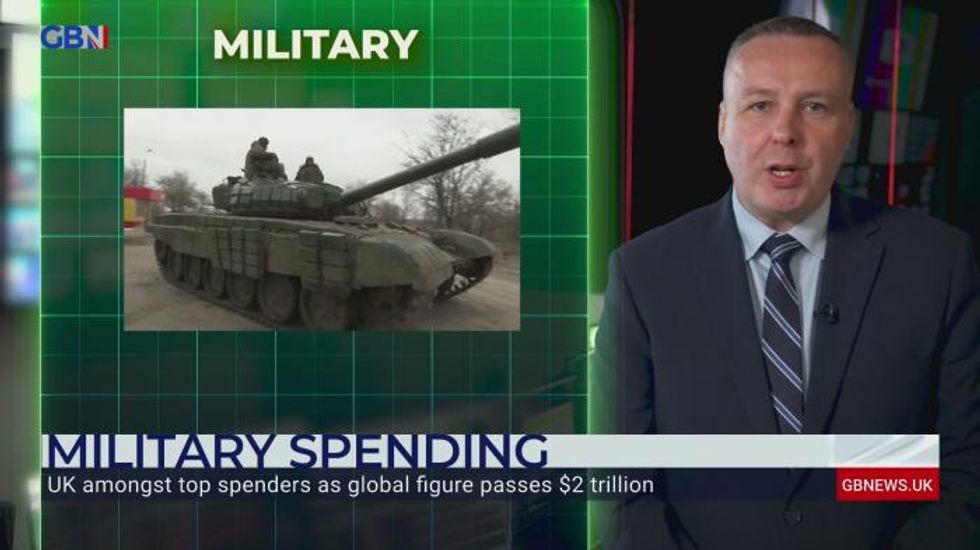UK named the fourth-highest military spender in 2021, beating Russia

This was the seventh consecutive year that spending increased, amid growing instability and political uncertainty in many parts of the World
Don't Miss
Most Read
Latest
The United Kingdom was the World’s 4th largest military spender last year, ahead of Russia and every other Nato ally, apart from the United States.
According to new data on global military spending by the Stockholm International Peace Research Institute (SIPRI) World military spending continued to grow in 2021, reaching an all-time high of more than $2.1 trillion.
This was the seventh consecutive year that spending increased, amid growing instability and political uncertainty in many parts of the World.
Image: PA
Daniel Leal
The top 5 military spenders last year were the United States, followed by China, India, the UK and Russia.
The UK spend £45 billion ($68.4 billion) in 2021.
That position, with the world’s 4th largest defence budget, comes at a time when the size of the British army is due to fall to around 70,000 personnel and there is a perceived shortage of big ticket items like ships, tanks and aircraft.
Military analysts have told GB News it shows the UK Ministry of Defence still has some way to go before achieving value for money in the procurement of much of its military equipment.
Image: PA
Daniel Leal
Dr Diego Lopes da Silva, Senior Researcher with SIPRI’s Military Expenditure and Arms Production Programme said:
“Even amid the economic fallout of the Covid-19 pandemic, world military spending hit record levels."
As a result of a sharp economic recovery in 2021, the global military burden - world military expenditure as a share of world gross domestic product (GDP) - fell by 0.1% from 2.3% in 2020 to 2.2% in 2021.
US military spending amounted to $801 billion in 2021, a drop of 1.4% from 2020.
The United States' military burden decreased slightly from 3.7% of GDP in 2020 to 3.5% in 2021.
US funding for military research and development rose by 24% over the past decade, while arms procurement funding fell by 6.4% over the same period.
"The increase in R&D spending over the decade 2012–21 suggests that the United States is focusing more on next-generation technologies." according to Alexandra Marksteiner, Researcher with SIPRI’s Military Expenditure and Arms Production Programme.
"The U.S. Government has repeatedly stressed the need to preserve the US military’s technological edge over strategic competitors." She added.
Russia increased its military expenditure by 2.9% in 2021, to $65.9 billion, at a time when it was building up its forces along the Ukrainian border.
Image: PA
Peter Nicholls
This was the third consecutive year of growth and Russia’s military spending reached 4.1% of GDP in 2021.
Lucie Béraud-Sudreau, Director of SIPRI’s Military Expenditure and Arms Production Programme, said:
"High oil and gas revenues helped Russia to boost its military spending in 2021.
"Russian military expenditure had been in decline between 2016 and 2019 as a result of low energy prices, combined with sanctions in response to Russia’s annexation of Crimea in 2014."
The national defence budget line, which accounts for around three-quarters of Russia’s total military spending and includes funding for operational costs as well as arms procurement, was revised upwards over the course of the year.
The final figure was $48.4 billion, 14% higher than had been budgeted at the end of 2020.
As it strengthened its defences against Russia, Ukraine’s military spending rose by 72% since the annexation of Crimea in 2014.
Image: PA
Richard Pohle/The Times
China, the world’s second largest spender, allocated an estimated $293 billion to its military in 2021, an increase of 4.7% compared with 2020.
China’s military spending has grown for 27 consecutive years.
Elsewhere in Asia, following initial approval of its 2021 budget, the Japanese Government added $7.0 billion to military spending.
As a result, spending rose by 7.3% to $54.1 billion in 2021, the highest annual increase since 1972.
Australian military spending also increased in 2021 by 4.0% to reach $31.8 billion.
"China’s growing assertiveness in and around the South and the East China seas has become a major driver of military spending in countries such as Australia and Japan." according to SIPRI Senior Researcher Dr Nan Tian.
"An example is the AUKUS trilateral security agreement between Australia, the United Kingdom and the United States, that foresees the supply of eight nuclear-powered submarines to Australia at an estimated cost of up to $128 billion.
India’s military spending of $76.6 billion ranked third highest in the world.
This was up by 0.9% from 2020 and by 33% from 2012.
Eight European NATO members reached the Alliance’s target of spending 2% or more of GDP on their armed forces in 2021.
This is one fewer than in 2020 but up from two in 2014.
Germany, the third largest spender in Central and Western Europe, spent $56.0 billion on
its military in 2021, or 1.3 per cent of its GDP.
Following the Russian invasion of Ukraine, Germany announced a massive increase in its future military spending, of €100 billion ($112 billion).
The Ukrainian invasion, combined with continued instability in other parts of the globe, will likely ensure another record level of global military spending this year.















